Alpine

Alpines, synonymous with French
Alpines, are the only dairy goat with erect ears
that can be multi-colored.
Specific French terms are used to define each of the colors or color combinations.
For example, the doe above is called chamoisee which is the specific term
describing brown or bay characteristic markings with a black face, dorsal
stripe, feet and legs, with or without a martingale running over the withers
and down to the chest. Alpines are a medium to large sized breed.
As stated, their ears should be erect and pointing forward like Saanens
and Toggenbergs. Their hair is medium to short depending on the climate.
They are very hardy and adaptable animals that can thrive in almost any
climate. Sometimes they can be more aggressive than other breeds,
but in many cases this lends to their hardiness. Roman noses, toggenburg
color and markings,
or an all white color is discriminated
against.
Most alpines are the direct descendents
of 19 does and 3 bucks imported in 1922
by Dr. DeLangle. Dr.
DeLangle, with the assistance of the chief authority of capriculture in
France at the time, personally chose these animals from the hundreds of
goats moving from the summer mountain pastures to the winter valley pastures.
These animals were shipped from Paris to California. Even today,
Alpine use and popularity is greatest on the west coast. They excelled
in commercial dairies in this area due to their long lactation despite
the hot climate. They are rapidly increasing in popularity on the east
coast and are numerous in the Midwest. Their increasing popularity combined
with their
prolificacy has allowed Alpines
to now rank second in annual registrations.
For more information about Alpines
contact Alpines International.
Lamancha
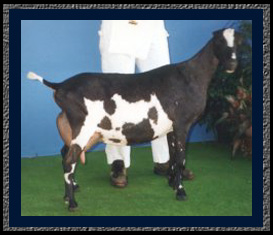
The LaMancha is easily identifiable
by their ears which come in two different types-
"gopher" ears or "elf" ears.
LaMancha does can have either type, but only bucks with the "gopher" ear
are eligible for registration. The "gopher" ear is a maximum of one
inch with little or no cartilage present. The "elf" ear is a maximum
of two inches with usually some amount of cartilage present.
In both cases, the end of the ear must turn up or down. The face
of the Lamancha is straight and the hair is short and fine. They
can come in any color or color combination.
The exact origins of LaManchas are
unknown. The best recorded reference to the breed goes
back to ancient Persia. It
is known that Spanish missionaries brought short-eared goats to California
for both milk and meat production and these are thought to be the ancestors
to most American LaManchas. The breed name LaMancha comes from a
crate of short-eared goats that were sent to the Paris World's Fair in
1904 with the inscription "LaMancha, Cordoba, Spain." The name has
stuck. The development of the breed occurred in the United States
during the first half of the 1900s. Phoebe Wilhelm owned the first
established herd of LaManchas in the 1920s. Wilhelm and other early
breeders, like Eula Fay Frey, contributed much to the breed. Few
true type animals were available during those early years; therefore, other
breeds were often used to propagate the LaManchas. However, The LaMancha
characteristics still dominated even after much hybridization. The
American LaMancha was first accepted as a breed for registry on January
27, 1958 and the popularity of these short-eared goats has increased ever
since.
For more information about LaManchas
contact the American LaMancha
Club.
Nubian
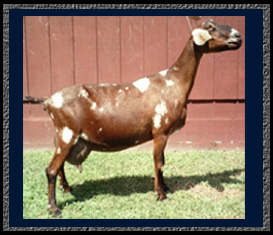
Nubians
are best known for their long pendulous ears, which must be a minimum of
one inch
beyond the muzzle when held flat
along the face. The ears should lie close to the head at the temple
and flare slightly our and forward at the tip, forming a "bell" shape.
They have a distinctly convex or Roman nose. Their short, fine hair
can be solid, spotted, or any other color combination. Nubians do
not tend to produce the quantity of milk as Swiss breeds, but their milk
is very high in butterfat ranging between 4 and five percent. Thus
it is excellent for making milk byproducts.
The Nubian type
goat is one of the oldest species of goat known. The present day Nubian
is primarily a combination of two
breeds- the Anglo and the Nubian. The original Nubian originated
in Nubia, a desert region in Northern Sudan. Even today Nubians are
noted as for being well adapted to hot climates. These original Nubians
spread into India and then Europe. In Europe, the breed was greatest
influenced by the British. The Anglo part of the ancestry includes
the English breed and various cross-bred animals including Persia, Abyssinian,
and Syrian goats. The British Goat Society recognized Anglo-Nubians
as a breed in 1896. In the early 1900s, a number of Nubian type does
were imported into the United States. Anglo was dropped from the
name and Nubians were registered as Purebred Nubians in the United States
by 1918.
For more information about Nubians contact the International Nubian Breeders Association.
Oberhasli
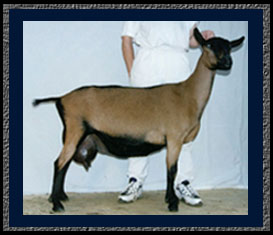
Oberhasli are
usually chamoisee with a deep red bay being more desirable than the
lighter shades. A recessive
gene in the breed causes some offspring from two chamoisee parents to be
black. Black does can be registered, but black bucks cannot.
Required markings are: two black stripes down the face from above
each eye to a black muzzle; forehead nearly all black, black stripes from
the base of each ear coming to a point just back of the poll and continuing
along the neck and back as a dorsal stripe to the tail; a black belly and
light gray to black udder; black legs below the knees and hocks; ears black
inside and bay outside. A few white hairs are allowed to be scattered
throughout the coat and about the ears. Bucks often have more black
in the characteristic areas and more white hairs scattered throughout the
coat than does. The face is straight and the ears are erect and pointed
forward.
The breed is medium in size like
the Toggenburg.
The Oberhasli originated near Berne,
Switzerland. They were first imported into the
United States by Dr. Pence in 1936.
The breed was known at this time as the Swiss Alpine and was registered
as a subgroup of the French Alpine. A separate Oberhasli registry
opened in 1980.
For more information about Oberhaslis
contact the Oberhasli Dairy Goat Homepage.
Saanen
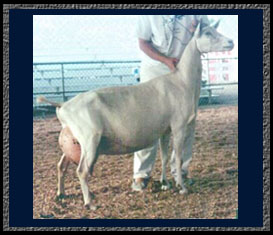
Saanens
are most easily identifiably by their uniform white to off white color.
They are
the largest of the dairy breeds
averaging between 31 and 32 inches. Their ears should be erect and
pointing forward like Alpines and Toggenbergs. They have short fine
hair like all dairy breeds, but a fringe will often be present over the
spine and thighs. This fringe is most prominent in bucks. Sannens
are best known for their heavy milk production. Saanen does currently
hold the milk production records according to figures furnished by USDA-AIPL
with production records
of 2351 lb milk, 3.4% butterfat,
and 3.1% protein.
Saanens originated from a valley
in the south of Canton Berne, Switzerland not surprisingly
called Saanen valley. In
the late 1800s, several thousand goats were taken from this valley and
spread throughout Europe. In the early 1900s around 150 Saanens were
imported into the United States from Europe. They have become one
of the most popular dairy breeds in America since that time.
For more information about Saanens
contact the National Saanen Breeders'
Association.
Toggenburg
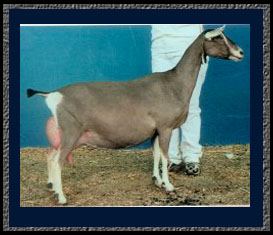
Toggenburgs
have a distinct color pattern. The body is a solid color ranging
from
light fawn to dark chocolate.
White markings must be on the ears except for the middle, down the face
from each to the muzzle, on the hindlegs from the hocks to hooves, on each
side of the tail in the form of small triangles. White on the forelegs
from the knees downward accompanied by a dark vertical stripe and white
at the base of any wattles are also acceptable in the breed standard.
Some cream markings are acceptable but are not desirable. The hair
is short to medium in length. The ears must be erect and carried
forward and the face must be dished or straight like the Alpines and Saanens.
Toggenburgs are a medium sized breeds weighing around 120 pounds. They
are often used in operations that produce cheese and other milk byproducts,
but Toggenburgs like Saanens tend to do best in cooler conditions. They
are a Swiss breed originating from the Toggenburg Valley of Switzerland
at Obertoggenburg. Toggenburgs are credited as being the oldest known dairy
goat breed.
For More Dairy Goat Information
Misty Mountain Alpines · FAQ ·
Goat
Links
Home
· About
Us · Aussies
Goats
· The Rest of the Farm
Interesting Tidbits